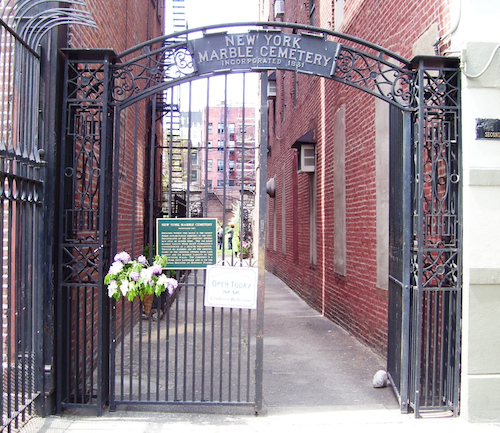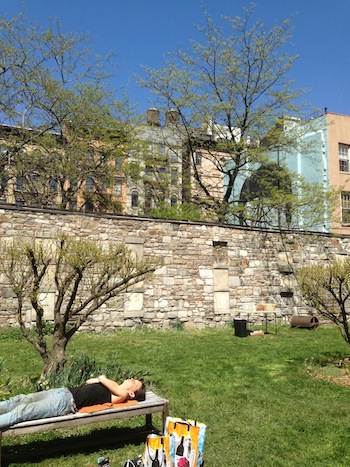
I spent several hours on Sunday afternoon in what has to be the most charming cemetery in New York City. If I didn’t know what I was looking for, I would have missed its arched iron gate, tucked into 2nd Avenue just north of East 2nd Street, where the East Village meets the Lower East Side. Once through, I walked a short brick-lined alley into something that looks more Middle-earth than Manhattan: a half-acre plot of bright green grass, lined by a 12-foot marble wall.
It was warm and sunny. A few locals had come to the secluded spot to picnic, sunbathe and read. A gray-haired woman was sitting under a tree, painting the scene from a wooden easel. I walked past them and joined a group sitting in green plastic chairs. We were there for the owners’ meeting.
 The New York Marble Cemetery (not to be confused, as I did on Sunday, with the larger and showier New York City Marble Cemetery, on the other side of 2nd Avenue) was built in 1830. It has 156 underground barrel vaults, holding the remains of more than 2,000 people. There are no garish tombstones; the vaults are marked with plain stone tablets nestled in the surrounding wall. One of my ancestors — Benjamin Wright, who was chief engineer of the Erie Canal and died in 1842 — bought, and now lies in, vault 83. That makes me an owner, and it means that I have the right to go in the vault, for free, whenever my time comes. The cemetery has thousands of owners. I counted 18 at the meeting.
The New York Marble Cemetery (not to be confused, as I did on Sunday, with the larger and showier New York City Marble Cemetery, on the other side of 2nd Avenue) was built in 1830. It has 156 underground barrel vaults, holding the remains of more than 2,000 people. There are no garish tombstones; the vaults are marked with plain stone tablets nestled in the surrounding wall. One of my ancestors — Benjamin Wright, who was chief engineer of the Erie Canal and died in 1842 — bought, and now lies in, vault 83. That makes me an owner, and it means that I have the right to go in the vault, for free, whenever my time comes. The cemetery has thousands of owners. I counted 18 at the meeting.
Caroline DuBois, from Oyster Bay, Long Island, is the leader of the cemetery’s board of trustees. For the past decade or so, she and a handful of other people have been working tirelessly to fix it up. It’s listed on the National Register of Historic Places, a special and official designation that means it will never become a skyscraper or condominium. It will be a cemetery until eaten by a massive sinkhole or drowned by rising seawaters.
The cemetery has already weathered a lot of change. The neighborhood began a slow decline not long after the cemetery was built; some families, DuBois told us, went so far as to move their dead relatives to swankier pastures in Brooklyn and the Bronx. The Lower East Side became an immigrant haven in the early 20th century and a crack den in the latter half. By the 1980s, a large section of the cemetery’s north wall had crumbled.
I stared at that gaping hole for most of the 80-minute meeting, while DuBois told us all about their slow and painful efforts to repair it. The masonry alone costs about $1,000 per running foot. Permits and regulations can be costly, too. Historic landmarks must use a particular type of expensive mortar, for example. At one point DuBois had to postpone the masons’ work because city laws demanded the wall be inspected for asbestos. The trustees spent some $40,000 on the north wall’s restoration last year and plan to spend more this year. Once that’s done, they’ll move on to the bigger project of the west wall, which butts up against the back of the Bowery Hotel. The 175-year-old wall was destroyed during the hotel’s construction several years ago. “It was a midnight bulldozer situation,” DuBois said. The trustees have exhausted every legal option to compel the hotel to pay for a replacement wall; nothing has worked. “They’re stonewalling us,” she said. We chuckled awkwardly at the pun.

DuBois also explained why the cemetery needs better fortification. Its neighbor on one side is a homeless shelter and on the other, a methadone clinic. “Bad guys come in at night,” DuBois said, leaving syringes and bottles behind. (One night several years ago, she added, the fire department barged in to stop a large brush fire caused accidentally by a man trying to keep warm.)
In the last couple of years, DuBois and the other trustees have come up with clever ways to raise money, mostly by renting out the grounds for weddings and other hip events. Stella McCartney held a fashion show there, and Blake Lively had a Vogue photo shoot under one of the cemetery’s trees. DuBois tried to market a spooky pumpkin-picking day in October, but it wasn’t too popular.
Those efforts notwithstanding, the group has nowhere near enough money to finish the walls, and few volunteers have come forward to help with the mailing lists, historical research, or tedious administrative work. So the trustees were hoping to convince the rest of us to donate to the effort, in the form of money, manpower, or both. Where do you live? they asked me several times. Brooklyn, I said. Do we have your email address?
I went to the meeting at the invitation of my aunt and uncle. It sounded like one of those impossibly quirky and wonderful New York events, plus I was curious to hear the spiel. But it didn’t move me. In fact, over the course of the meeting, I couldn’t help but wonder: why would anybody choose this strange little cemetery as their cause célèbre? Why does DuBois drive over from Oyster Bay to put on open houses and sell pumpkins? Why has Anne Brown, another trustee, spent years collecting old photographs of the people in the vaults? What’s the point of it all?
Maybe their parents and grandparents were right there under my feet, I thought, and keeping the cemetery vibrant was a way to honor their memory. But no. The cemetery’s last burial, DuBois told us cheerfully, was in 1937. She does, of course, plan to be buried there herself one day.
The dead, past or future, are not my cause. And tracing ancestry is not really my thing, either (as I’ve written about before on this blog). Isn’t it a waste, after all, to spend precious years of our waking lives in service to death?
On the other hand, there are worse places to end up than vault 83.
*
Virginia Hughes is a science writer based in Brooklyn. She writes about genes, brains, drugs, and other stuff on her blog, Only Human.
Top photo courtesy of Wikipedia, the rest by Virginia.
Very interesting!
…The past isn’t dead. it isn’t even over….
You can quote me on that
Hi Victoria,
The point of it all is to preserve history and open green space in New York City. It is not just about the dead – it is about the living, many of whom were enjoying the space on Sunday when you were there. Imagine what New York City would look like without any historic preservation efforts. What is so strange about that?
Thanks, anonymous. I certainly see your point, there. It’s a very small space, however, and usually closed to the public. So I think in this case it is more about the dead…
It is a small but good thing that these people are doing. They are preserving a small but beautiful part of our heritage and showing respect for the people who helped make our world, your ancestor being not the least of them.
Having said that, I admit that I would not want to spend my time on the project. But you remind me a bit of Sen. McCain railing against the money spent to get DNA from grizzlies at Yellow Stone National Park. Just a little bit. A wee little bit. It is just that neither project needs to be useful. Preservation of our history and gathering scientific knowledge need no further justification.
I’m going to play devil’s advocate here, and hopefully won’t come off as a jackass. But there’s a difference between putting money/effort into science (the pursuit of new knowledge) and putting money/effort into…old stuff.
Should we preserve everything that’s old? How about grandma’s enormous collection of old, junky pottery? At what point does our preservation of the past get in the way of future growth?